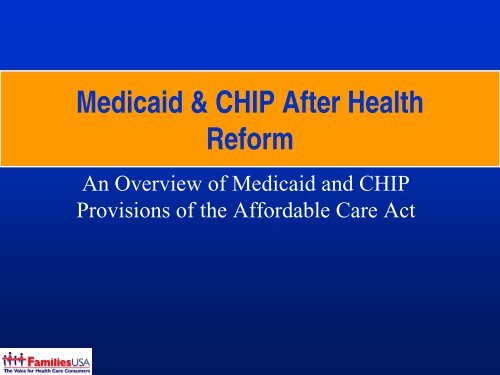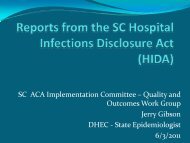Medicaid & CHIP After Health Reform - South Carolina Institute of ...
Medicaid & CHIP After Health Reform - South Carolina Institute of ...
Medicaid & CHIP After Health Reform - South Carolina Institute of ...
You also want an ePaper? Increase the reach of your titles
YUMPU automatically turns print PDFs into web optimized ePapers that Google loves.
<strong>Medicaid</strong> & <strong>CHIP</strong> <strong>After</strong> <strong>Health</strong><br />
<strong>Reform</strong><br />
An Overview <strong>of</strong> <strong>Medicaid</strong> and <strong>CHIP</strong><br />
Provisions <strong>of</strong> the Affordable Care Act
<strong>Medicaid</strong> Eligibility Expansion<br />
• New mandatory eligibility category for nonelderly<br />
adults, income up to 133% <strong>of</strong> poverty<br />
($28,000 for a family <strong>of</strong> 3 in 2010)<br />
– Must be citizen or legal resident >5 years<br />
– Increases mandatory eligibility for children ages 6-<br />
18 from 100% to 133% <strong>of</strong> poverty (<strong>CHIP</strong><br />
matching rate)<br />
– Estimated 76.% decline in uninsured adults
Financing
Financing the Expansion, 2014-2019<br />
Source: John Holahan and Irene Headen, “<strong>Medicaid</strong> Coverage and Spending in<br />
<strong>Health</strong> <strong>Reform</strong>: National and State-by-State Results for Adults at or Below 133%<br />
FPL” (Washington: Kaiser Commission on <strong>Medicaid</strong> and the Uninsured, May 2010).<br />
Estimates above reflect higher participation rate scenario.<br />
5
<strong>Medicaid</strong> Expansion in <strong>South</strong> <strong>Carolina</strong>:<br />
Current vs. New Eligibles, 2014-2019<br />
Source: John Holahan and Irene Headen, “<strong>Medicaid</strong> Coverage and Spending in<br />
<strong>Health</strong> <strong>Reform</strong>: National and State-by-State Results for Adults at or Below 133%<br />
FPL” (Washington: Kaiser Commission on <strong>Medicaid</strong> and the Uninsured, May 2010).<br />
Estimates above reflect higher participation rate scenario.<br />
6
<strong>Medicaid</strong> Spending in <strong>South</strong> <strong>Carolina</strong>, 2014-2019<br />
$45,000<br />
$40,000<br />
$35,000<br />
$12,109<br />
$30,000<br />
$25,000<br />
$20,000<br />
$15,000<br />
$615<br />
$30,353<br />
New Spending<br />
Baseline Spending<br />
$10,000<br />
$5,000<br />
$12,984<br />
$0<br />
<strong>South</strong> <strong>Carolina</strong><br />
Federal Government<br />
Source: John Holahan and Irene Headen, “<strong>Medicaid</strong> Coverage and Spending in <strong>Health</strong><br />
<strong>Reform</strong>: National and State-by-State Results for Adults at or Below 133% FPL”<br />
(Washington: Kaiser Commission on <strong>Medicaid</strong> and the Uninsured, May 2010).<br />
Estimates above reflect higher participation rate scenario.<br />
7
Who Will Gain Coverage?<br />
• Estimated 443,020 new <strong>Medicaid</strong> enrollees by<br />
2019<br />
• 76.2% decrease in uninsured adults with<br />
income
Growth in <strong>Medicaid</strong> Enrollment in <strong>South</strong><br />
<strong>Carolina</strong><br />
Source: John Holahan and Irene Headen, “<strong>Medicaid</strong> Coverage and Spending in <strong>Health</strong><br />
<strong>Reform</strong>: National and State-by-State Results for Adults at or Below 133% FPL”<br />
(Washington: Kaiser Commission on <strong>Medicaid</strong> and the Uninsured, May 2010).<br />
Estimates above reflect higher participation rate scenario.<br />
9
Benefits for the Newly Eligible<br />
• Benchmark/benchmark equivalent benefits<br />
• Must include “essential health benefits”<br />
– Ambulatory care, emergency, hospital, maternity/newborn,<br />
behavioral health, Rx drugs, rehabilitative and habilitative<br />
services, lab services, preventive/wellness/disease<br />
management, pediatric services including oral and vision<br />
• Also must include family planning services<br />
and transportation services<br />
• Dental and vision not required for adults<br />
10
Benefits (continued)<br />
• Existing <strong>Medicaid</strong> cost-sharing rules apply<br />
• New enrollees may have greater need for:<br />
– Mental health services<br />
– Chronic disease management<br />
• Given 2/3 were previously uninsured, may be<br />
pent up demand in early years <strong>of</strong> expansion<br />
11
MAGI<br />
What does MAGI mean for health reform?<br />
12
MAGI<br />
• Modified Adjusted Gross Income<br />
• Applies to children, parents, pregnant women<br />
and other adults in <strong>Medicaid</strong> and <strong>CHIP</strong><br />
• Income as reported on federal tax forms<br />
• No disregards other than universal 5%<br />
• No assets tests<br />
•Does not apply to seniors, ABD, duals<br />
13
MAGI: Easier for Some Groups to Qualify<br />
• People with disabilities or chronic conditions<br />
• People in 2 year Medicare waiting period<br />
• People with child support income<br />
• People with social security survivor income<br />
• Issue: ensuring the eligibility determination<br />
process is set up to screen people who do not<br />
qualify under disability rules with MAGI<br />
14
Potential Problems with MAGI<br />
• Could cause gaps for:<br />
– Children who live with a stepparent<br />
– Pregnant women<br />
– Children claimed by non-custodial parent on tax<br />
forms<br />
• Coordination for those on border between<br />
<strong>Medicaid</strong> and premium tax credit eligibility<br />
15
Access to Care for New Eligibles<br />
• Increased reimbursement rates for primary care<br />
providers<br />
– Pegged to Medicare rates<br />
– Two years starting in 2013<br />
– Fully federally financed<br />
• Incentive to provide preventive services<br />
– One percentage point increase in federal matching rate<br />
if A and B level preventive services covered (as<br />
defined by the US Preventive Services Task Force)<br />
16
Immigrants<br />
• Undocumented immigrants<br />
– Remain ineligible for public programs<br />
– Ineligible for premium tax credits<br />
– May not purchase coverage through the exchange<br />
• Documented immigrants, in country 5 years<br />
– Eligible for public programs<br />
– Eligible for premium tax credits if income too high for <strong>Medicaid</strong><br />
– Eligible to purchase coverage through the exchange if ineligible for tax<br />
credits<br />
17
Improving Enrollment in Public Programs<br />
• New policy options<br />
– Presumptive eligibility for all new <strong>Medicaid</strong> eligibles<br />
plus currently-eligible parents<br />
– Hospitals that accept <strong>Medicaid</strong> can conduct<br />
presumptive eligibility for all <strong>Medicaid</strong><br />
• Outreach to vulnerable populations required<br />
• Additional $40 million for <strong>CHIP</strong>RA outreach<br />
grants<br />
• Streamlining enrollment and renewal processes<br />
with the exchange<br />
18
Coordinating Enrollment between the Exchange and<br />
Public Programs<br />
• Simple for consumers; not simple for state and<br />
advocates to integrate and implement<br />
• No wrong door<br />
• Data sharing<br />
• Screening requirements<br />
19
What Can My State Do Before 2014?<br />
• States can expand coverage before 2014<br />
• Expansions get regular match, but then still<br />
get full 100% match in 2014<br />
• Simplification <strong>of</strong> eligibility & enrollment<br />
can be done anytime
What Must My State Do Before 2014?<br />
• Plan for access to care for additional<br />
enrollees: provider networks<br />
• Plan for coordination <strong>of</strong> <strong>Medicaid</strong> eligibility<br />
system with state or federal exchange




